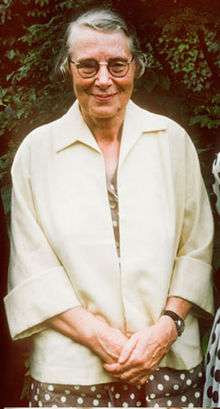Irene Manton

Irene Manton, FRS[1] (born Irène Manton; 17 April 1904, Kensington – died 13 May 1988) was a British botanist. She was noted for study of ferns and algae.
Biography
Irene Manton was born of a dentist and a descendant of French aristocracy. Hence her first name originally contained French influences, but at 18 she dropped this and opted for "Irene". Her sister was the entomologist Sidnie Manton FRS. She was educated at the Froebel Demonstration School and St. Paul's Girls' School, Hammersmith.
In 1923 she attended Girton College, Cambridge. She found Cambridge unsatisfying, in part because the university as a whole was not yet welcoming of women, and later went on to study with Gustaf Otto Rosenberg in Stockholm. She received her PhD at the University of Manchester with her thesis being on Cruciferae.
Much of her academic career was spent at the University of Leeds where she was Professor of Botany from 1946 until 1969 and Professor Emeritus thereafter [2] and where her focus was on ferns and algae. The work with ferns, which addressed hybridization, polyploidy, and apomixis, included her 1950 book, Problems of cytology and evolution in the pteridophyta. Her work on the algae was notable for its use of the electron microscope with her cytological work known worldwide for the structure of cilia and flagella she revealed.[1][3] She was author or co-author of over 140 scientific publications.
Irene Manton bequeathed her collection of modern and oriental art to the University of Leeds. Many of these pictures hung on the walls of Botany House in the University of Leeds during her career there.[4]
Honours
In 1969 Manton shared the Linnean Medal with Ethelwynn Trewavas.
She was appointed as the first female President of the Linnean Society of London from 1973 to 1976.
She was elected a Fellow of the Royal Society in March 1961 for her work on the ultramicroscopic structure of plants and on their evolution.[5]
In 1969 she was elected a Foreign Honorary Member of the American Academy of Arts and Sciences.[6]
In 1972, Manton was awarded the Schleiden Medal by the Academy of Sciences Leopoldina.[7][8]
Legacy
_019.jpg)
In 1990 the Irene Manton Prize for the best dissertation in botany during an academic year was established by the Linnean Society.
In 1998, the tenth anniversary of her death, the Biological Sciences building at the University of Leeds was named the Irene Manton Building in her honour.[2]
The British Phycological Society awards the Irène Manton prize annually for the best postgraduate student presentation at its annual scientific meeting.[9]
Selected publications
- Manton, I., Sutherland, J., Leadbeater, BSC. "Further observations on fine structure of marine collared flagellates (Choanoflagellata) from arctic Canada and West Greenland - species of Parviorbicula and Pleurasiga." Canadian J Botany - Revue Canadienne de Botanique, Vol 54 (1976) pp 1932–1955
- Parke, M., Green JG., Manton I. "Observations on fine structure of zoids of genus Phaeocystis [Haptophyceae]." Journal of the Marine Biological Association (UK), Vol 51 (1971) pp 927-
- Manton, I., Kowallik, K., Stosch, HAV. " Observations on fine structure and development of spindle at mitosis and meiosis in a marine centric diatom (Lithodesmium undulatum) 4. Second meiotic division and conclusion." J Cell Science, Vol 7 (1970) pp 407 -
- Manton, I., Leedale, GF. " Observations of microanatomy of Coccolithus pelagicus and Cricosphaera carterae with special reference to origin and nature of coccoliths and scales." Journal of the Marine Biological Association (UK), Vol 49 (1969) pp 1 -
- Provasol, L., Yamasu, T., MantonI. " Experiments on resynthesis of symbiosis in Convoluta roscoffensis with different flagellate cultures." Marine Biol Asscn (UK), Vol 48 (1968) pp 465 -
- Manton, I. " Observations on fine structure of 2 species of Platymonas with special reference to flagellar scales and mode of origin of theca." Journal of the Marine Biological Association (UK), Vol 45 (1965) pp 743 -
- Manton, I. " Observations on fine structure of zoospore and young germlings of Stigeoclonium." J. Exp. Botany, Vol 15 (1964) pp 399 -
- Manton, I., Parke, M. "Further observations on small green flagellates with special reference to possible relatives of Chromulina pusilla Butcher." Journal of the Marine Biological Association (UK), Vol 39 (1960) pp 275 -
- Parke, M., Manton, I., Clarke, B., "Studies on marine flagelllates 2. 3 new species of Chrysochromulina." Journal of the Marine Biological Association (UK), Vol 34 (1955) pp 579 -
- Manton, I., Clarke, B. "An electron microscopic study of the spermatozoid of Sphagnum." J Exp. Botany, Vol 3 (1952) pp 265- DOI: 10.1093/jxb/3.3.265
- Manton, I., Clarke, B., Greenwood AD. "Observations with the electron microscope on a species of Saprolegnia." J. Exp. Botany, Vol 2 (1951) pp 321 -
- Manton, I. "The spiral structure of chromasomes." Biol Reviews Cambridge Philosophical Society, Vol 25 (1950) pp 486 – 508. DOI: 10.1111/j.1469-185X.1950.tb00770.x
- Manton, I. "New evidence on the telophase split in Todea barbara." American J. Botany, Vol 32 (1945) pp 342–348 DOI: 10.2307/2437168
- Manton, I, "Introduction to the general cytology of the Cruciferae." Annals of Botany, Vol 46 (1932) pp 509–556
References
- 1 2 Preston, Reginald Dawson (1990). "Irene Manton. 17 April 1904-13 May 1988". Biographical Memoirs of Fellows of the Royal Society. 35: 248. doi:10.1098/rsbm.1990.0011.
- 1 2 University of Leeds, Reporter 420, 11 May 1998
- ↑ Linnean Society biography
- ↑ "Women in Science series // Irene Manton". Lippy: No Gloss. 18 November 2012.
- ↑ "Lists of Royal Society Fellows 1660-2007". London: The Royal Society. Retrieved 14 July 2010.
- ↑ "Book of Members, 1780–2010: Chapter M" (PDF). American Academy of Arts and Sciences. Retrieved 22 July 2014.
- ↑ Marilyn Bailey Ogilvie and Joy Harvey (16 Dec 2003). The Biographical Dictionary of Women in Science. Routledge. p. 838. ISBN 9781135963439.
- ↑ "Academy of Sciences Leopoldina - Schleiden Medal - Laureate". Academy of Sciences Leopoldina. Retrieved 9 May 2015.
- ↑ "British Phycological Society Meetings". British Phycological Society. British Phycological Society. Retrieved 8 April 2015.
- ↑ IPNI. Manton.